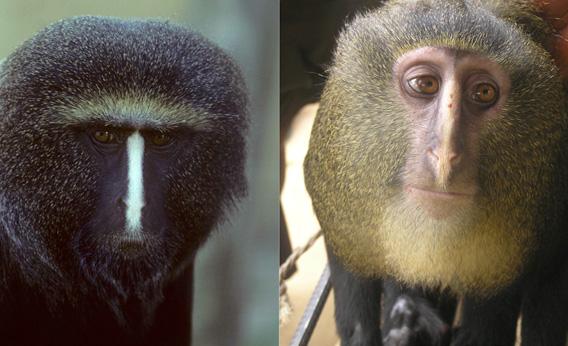
Cercopithecus hamlyni.
Photos by Noel Rowe and Maurice Emetshu.
It?s been a great year for newly discovered wildlife. Some of the plants and animals documented for the first time come from places like Papua New Guinea that are teeming with species unknown to science. Others come from college-town backyards.
Scientists discovered Cercopithecus lomamiensis, also known as the lesula monkey, in the Democratic Republic of Congo. The lesula has a striking expression, but the monkey?s unusual coloring was what helped scientists realize it might be a new species. The lesula is already endangered, in part due to local bush-meat hunting.
Auburn Tiger Trapdoor Spider

Myrmekiaphila tigris.
Photo by J. Bond.
This new species of spider, Myrmekiaphila tigris, was discovered in a backyard in Auburn, Ala. These spiders were once thought to belong to a different species. Some bad news for people with arachnophobia: Males wander the sidewalks in large groups in search of mates. Males die shortly after mating, but females live 15 to 20 years.

Paedophryne amanuensis.
Photo courtesy Rittmeyer EN et al/Wikimedia Commons.
Paedophryne amanuensis is not only the world?s smallest known frog but also the world?s smallest known vertebrate. Scientists found the species in Papua New Guinea. Adults range from 7 to 8 millimeters in length.
Anguilla Bank Skink Lizard

Anguilla Bank skink.
Photo by Karl Questel.
Scientists have discovered 24 new species of skinks in the Caribbean. The blue-tailed skink pictured above is the Anguilla Bank skink. Many of the newfound species are in danger of extinction because humans have introduced predatory animals into the island ecosystem.

Bythaelurus giddingsi.
Photo by John E. McCosker.
This little shark, called Bythaelurus giddingsi, looks like a cross between a shark and a catfish. Scientists found it in the Galapagos Islands.

Mimulus peregrines.
Photo by Dr. Mario Vallejo-Marin.
This beautiful flower, called Mimulus peregrines, was found in Scotland. Originally a hybrid of two other flowers, the monkey flower evolved to overcome infertility and reproduce on its own.
Reticulated Dragonet Fish

Callionymus reticulates.
Photo by Lars-Ove Loo.
The reticulated dragonet fish differs only slightly from other dragnet fish?it has only three spines on its gill cover instead of four, and it has a longer snout. But scientists rarely discover new species of fish in Sweden. Its scientific name is Callionymus reticulates.
 Brookesia micra
Brookesia micra Photograph courtesy Frank Glaw.
The Brookesia micra is the tiniest of four chameleons found this year in Madagascar. Adults are just over an inch long, making it one of the smallest known reptiles in the world.

Slow loris.
Photo courtesy Ch'ien C. Lee
Slow Loris
What was once thought to be a single species on the island of Borneo was split into four distinct slow loris species. The primates are nocturnal, tree-dwelling, and have a venomous bite.
Source: http://feeds.slate.com/click.phdo?i=6fbcf6ad139d1ec76f007facc3e63f74
best picture 2012 oscar winners channel 3 news j lo j lo sacha baron cohen ryan seacrest octavia spencer
No comments:
Post a Comment
Note: Only a member of this blog may post a comment.